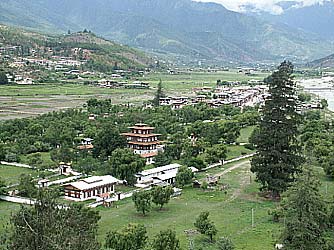 |
|
Festivals
in Bhutan
|
 |
 |
 |
Bhutan
Festivals |
|
 |
Bhutan
Festivals |
|
|
 |
| Thri
in Paro Festival in 2002 |
 |
Ugyen Pelri palace in Paro
| His
Holiness the Je Khenpo, Trulku Jigme Chhoeda, is conducting a two-week
sacred Thri (admonition) ceremony at Ugyen Pelri palace in Paro.
The programme included a wang-lung (blessing and oral transmission)
ceremony and grouping of devotees into "families". The
Thri, which many Bhutanese aspires to receive once in a lifetime, has two
literal meanings: "to elucidate, elaborate, intsruct, or to explain", and
the other is "to lead or to bring along with". |
|
During
the ceremony, the moral precepts and the teachings of the Buddha are elucidated
for the benefit of all devotees to set them on the path to enlightenment
or ultimate liberation.
The
transmission of the Thri can be traced back to His Holiness Gampopa from
whom originated several Kagyu lineages. His Holiness Gampopa had
upheld the two aspects of Mahamudra (Chhagja Chhenpo): Mahamudra
of Sutra (Do) and the Mahamudra of Mantra (Ngag). This lineage
was transmitted in the Drukpa Kagyue tradition through an unbroken
line of masters down to the present Je Khenpo who is transmitting
it to more than 6,000 devotees in this ceremony.
The
devotees are guided in oral benediction or instructions on the preliminary
training. They perform prostrations, recitation of mantras, make
offerings and sing hymns in praise of the spiritual preceptor.
After
receiving the Thri the devotees are expected to abide by the fundamental
ethical injunctions taught to them to enable them to lead pure moral
lives and to carry out the preliminary practices for higher spiritual attainments.
The sole aim of such lives is to gain the ultimate liberation from the
cycle of existence and suffering in the Samsara (Khorwa).
Eighty-year old Sonam, who travelled all the way from Ngatshang in Mongar
receiving Thri from Je Khenpo was like Buddha's blessing and listening
to the teachings of Ugyen Guru Rinpoche. "I was fortunate
to attend the sacred ceremony," said a devotee Aum Tshering Pem, 71, who
walked three days from Gasa to attend Thri. "Now I have no regrets even
if I die".
Dance
of Guru Rinpoche
| His
Holiness the Je Khenpo united devotees from all walks of life into one
family as the seven Dorji Puens (spiritual brothers and sisters) who develop close relations and introduce them to their own families and
relatives. The devotees were grouped into Dorji Puens of seven with one
or two monks in each "family". The Dorji Puen is not just seven individuals
but they symbolise seven Buddhas. It is believed that the founder of
the Drukpa School, Dro Goen Tsangpa Jarey was meditating at the foot
of a tree when the seven Buddhas (Sangay Rabduen) revealed to him the sacred
teachings known as Tendrel Gi Choe (auspicious teachings of cause and
effect). |
|
 |
It
is after the seven Buddhas revealed to Tsangpa Jarey these
sacred teachings that the system of Dorji Puens developed.
The
empowerment of the Thri ceremony is of paramount importance to those devotees
who wish to enter into the sacred path of Tantra. The lay devotees
believe that the empowerment helps to purify them from adventitious defilements,
alleviate their sicknesses, increase their life span, endow them with faith,
wisdom, and compassion, and set them on the path of higher spiritual attainments.
The
ceremony was organised on the request of the Rinpung rabdey, dzongkhag
administration, and the people of Paro, for the spiritual well being of
the people, the country, and all sentient beings.
 |
Je Khenpo
| His
Holiness the Je Khenpo, Trulku Jigme Chhoeda, is conducting a two-week
sacred Thri (admonition) ceremony at Ugyen Pelri palace in Paro.
The programme included a wang-lung (blessing and oral transmission) ceremony
and grouping of devotees into "families". The Thri, which many
Bhutanese aspires to receive once in a lifetime, has two literal meanings:
"to elucidate, elaborate, intsruct, or to explain", and the other is "to
lead or to bring along with". |
|
During
the ceremony, the moral precepts and the teachings of the Buddha are elucidated
for the benefit of all devotees to set them on the path to enlightenment
or ultimate liberation. The transmission of the Thri can be traced
back to His Holiness Gampopa from whom originated several Kagyu lineages.
His
Holiness Gampopa had upheld the two aspects of Mahamudra (Chhagja Chhenpo):
Mahamudra of Sutra (Do) and the Mahamudra of Mantra (Ngag). This lineage
was transmitted in the Drukpa Kagyue tradition through an unbroken line
of masters down to the present Je Khenpo who is transmitting it to
more than 6,000 devotees in this ceremony. The devotees are guided
in oral benediction or instructions on the preliminary training. They perform
prostrations, recitation of mantras, make offerings and sing hymns
in praise of the spiritual preceptor. After receiving the Thri the devotees
are expected to abide by the fundamental ethical injunctions taught to
them to enable them to lead pure moral lives and to carry out the
preliminary practices for higher spiritual attainments. The sole aim of
such lives is to gain the ultimate liberation from the cycle of existence
and suffering in the Samsara (Khorwa).
|





